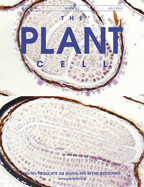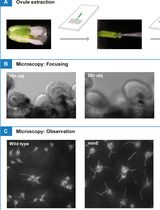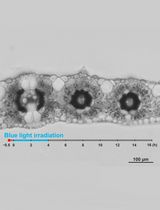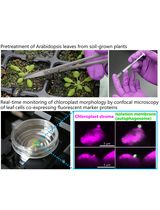- EN - English
- CN - 中文
A Bioimaging Pipeline to Show Membrane Trafficking Regulators Localized to the Golgi Apparatus and Other Organelles in Plant Cells
植物细胞中高尔基体和其它胞器的膜转运调节因子的生物成像
发布: 2015年09月05日第5卷第17期 DOI: 10.21769/BioProtoc.1583 浏览次数: 10417
评审: Arsalan DaudiRenate WeizbauerAnonymous reviewer(s)
Abstract
The plant Golgi apparatus is composed of numerous stacks of cisterna, designated as cis, medial, and trans Golgi cisternae; these stacks move within the cytoplasm along the actin cytoskeleton. Cis cisternae receive secretory products from endoplasmic reticulum (ER) and they subsequently progress through the stack to the trans cisternae, where they are sorted to other destinations, including cell wall, plasma membrane (PM), vacuoles, and chloroplasts. In addition, the plant Golgi apparatus plays a role of glycosylating proteins as well as synthesizing cell wall polysaccharides, such as hemicelluloses and pectins. This protocol describes procedures for imaging fluorescently-tagged proteins localized to the plant Golgi apparatus of Arabidopsis seedlings using confocal laser microscopy (CLSM), total internal reflection fluorescence microscope (TIRF), and immunogold labeling of high-pressure frozen/freeze substituted samples by transmission electron microscopy (TEM). We particularly focus on long-term time lapse imaging and protein localization in subdomains within the Golgi. This protocol can be also used for other organelles, tissues, and plant species.
Materials and Reagents
- ½X Murashige and Skoog (MS) medium (Sigma-Aldrich, catalog number: M5519 )
- Bacto Agar [Becton, Dickinson and Company (BD), catalog number: 2140101 ]
- Arabidopsis thaliana seedlings, expressing Golgi-localized proteins fused to a fluorescent protein (e.g. 35S::ST-mRFP in Col, 35S::ERD2-GFP in Col, pGNL1:: GNL1-YFP in gnl1, pGNOM::GNOM-GFP in gnom)
- Inhibitors [such as BrefeldinA (BFA) (Sigma-Aldrich, catalog number: B7651 ), monensin (Sigma-Aldrich, catalog number: M5273 ), salinomycin (Sigma-Aldrich, catalog number: S4526 )]
- Dimethyl sulfoxide (DMSO) (Wako Chemicals USA, catalog number: 046-2198 )
- Freezing planchets type B (Ted Pella, catalog number: 39201 )
- Sucrose (Wako Chemicals USA, catalog number: 196-00015 )
- 1.8 ml cryovials [for example: Nunc® cryotubes (Sigma-Aldrich, catalog number: V7884-450EA )]
- Methacrylate-based resin (Lowicryl HM20 resin kit) (Electron Microscopy Sciences, catalog number: 14340 )
- Sodium phosphate monobasic (NaH2PO4) (Sigma-Aldrich, catalog number: S8282-500G )
- Sodium phosphate dibasic (Na2HPO4) (Sigma-Aldrich, catalog number: S7907-100G )
- Liquid nitrogen
- 0.5% Formvar solution (Electron Microscopy Sciences, catalog number: 15820 )
- Tween-20 (Sigma-Aldrich, catalog number: P1379-25ML )
- Primary antibodies against fluorescent tag [e.g. green fluorescent proteins(GFP)]
- Secondary antibodies conjugated to gold nanoparticles (5, 10, or 15 nm in diameter)
- Cryo-substitution solution (see Recipes)
- Lead citrate (see Recipes)
- Uranyl actetate solution (see Recipes)
- Phosphate-buffer saline (PBS) stock solution (10x) (see Recipes)
- 0.1% Tween-20 in PBS (PBS-T-0.1%) (see Recipes)
- 0.5% Tween-20 in PBS (PBS-T-0.5%) (see Recipes)
- Blocking buffer (see Recipes)
- HM20 resin solutions (see Recipes)
Equipment
- Coverwell® silicone imaging chambers (2.5 mm deep, 20 mm diameter) (Electron Microscopy Sciences, catalog number: 70326-16 )
- Nickel slot grids (Electron Microscopy Sciences, catalog number: 2015-Ni )
- 0.12-0.17 mm thick coverslips (Matsunami Glass, catalog number: C022221 )
- Light Forceps (Hammacher, catalog number: HWC 118-10 )
- Lab-Tek Chambered Coverglass (Thermo Fisher Scientific, catalog number: 155361 )
- 0.9-1.2 mm thick Glass slides (Matsunami Glass, catalog number: S24410 )
- Parafilm
- 22 °C plant growing chamber
- Inverted confocal Microscope (Olympus, model: FV1200 )
Note: equipped with 473 nm or 559 nm diode laser and with water immersion 63x / 1.20 numerical aperture objectives or oil immersion 100x / 1.40 numerical aperture objectives - TIRF Microscope equipped with oil immersion CFI Apo TIRF 100x H / 1.49 numerical aperture objectives (Nikon, model: Eclipse TE2000-E with TIRF2 system)
- High-pressure freezer (Leica, model: EM HPM100 or Bal-tec/RMC/ABRA Fluid AG, model: HPM 010 )
- Automated freeze-substitution and low-temperature resin embedding/polymerization system (for example, Leica, model: AFS2 )
- Ultramicrotome (for example, Leica, model: EM UC7 ultramicrotome )
- Glass knife maker (for example, Leica, model: EM KMR3 )
- Ultra 45° diamond knife or other types of wet diamond knives (Diatome AG)
- Transmission electron microscope (for example, FEI, model: Tecnai 12 )
Procedure
文章信息
版权信息
© 2015 The Authors; exclusive licensee Bio-protocol LLC.
如何引用
Naramoto, S., Dainobu, T. and Otegui, M. S. (2015). A Bioimaging Pipeline to Show Membrane Trafficking Regulators Localized to the Golgi Apparatus and Other Organelles in Plant Cells. Bio-protocol 5(17): e1583. DOI: 10.21769/BioProtoc.1583.
分类
植物科学 > 植物细胞生物学 > 细胞成像
细胞生物学 > 细胞成像 > 共聚焦显微镜
细胞生物学 > 细胞成像 > 电子显微镜
您对这篇实验方法有问题吗?
在此处发布您的问题,我们将邀请本文作者来回答。同时,我们会将您的问题发布到Bio-protocol Exchange,以便寻求社区成员的帮助。
Share
Bluesky
X
Copy link














